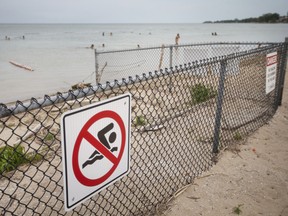Summer has barely begun and the Great Lakes have already claimed 47 lives through drownings this year, according to the Great Lakes Surf Rescue Project, which also pegs the number of rescues of people plucked from the water at 12 so far in 2022.

Summer has barely begun and the Great Lakes have already claimed 47 lives through drownings this year, according to the Great Lakes Surf Rescue Projectwhich also pegs the number of rescues of people plucked from the water at 12 so far in 2022.
Something many beachgoers might not realize is that the Great Lakes boast the same kinds of potentially deadly rip currents more commonly thought to be only a danger off ocean tidal beaches. Even the term generally used, rip tide, makes “people assume this must be a marine event, something you get on the Atlantic or Pacific,” said University of Windsor researcher Chris Houser.
A spate of recent drownings in the Great Lakes, however, including the death a few weeks ago of one beachgoer near Leamington, “has put the spotlight on beach safety” here, according to Houser, who is the dean of the university’s faculty of science . He also heads the Coastal Research Groupa research body with field sites across the Great Lakes, in the Maritimes and in Costa Rica that is studying the physical and social dimensions of the drowning hazard posed by rip and shoreline currents.
“We’ve done a lot of surveys, and the vast majority (of respondents) are not able to identify rips,” said Houser.
The biggest misconception is that people tend to associate calm water with safe water. Depending on the wave and water action on either side, lurking below that stretch of calmness off the beach could be a fast-moving channel of water — a rip — powerful enough to drag even a good swimmer further away from the shore.
“Summer and swimming is a lot of fun, but sometimes the water is safe and sometimes it’s not,” said Houser.
The Windsor-based Coastal Research Group, which conducts work in Lake Erie’s western basin, in Lake Huron and the coastlines of Prince Edward Island, Texas, Florida and Costa Rica, is looking at all aspects of tackling what is usually a hidden danger.

Even at Sand Point Beach, Windsor’s only public swim beach, Houser said there are lifeguards and warning signs, but beachgoers tend to ignore those because “group behavior tends to dominate what we see — what we see are others in the water.” That observation might indicate safety or lead weaker swimmers to overestimate their abilities.
Part of the Coastal Research Group’s work is looking at designing the types of warning systems that can be effective and researching how to create “social norms” so beachgoers are better informed and educated about potential risks.
Rip currents are common across the Great Lakes and can be the result of a number of factors, including how the beach and shoreline are shaped; wind and wave action at any particular time; and water action around fixed structures like groynes and jetties.
Some tips: when a sandy shoreline bends inward or when waves on either side of a calm stretch are breaking to the left and to the right, there’s a good chance of a rip current.

When caught in a rip current, doing the right thing is easier said than done, according to Houser. First, and most importantly, “don’t panic. Never try to fight it,” he said, adding that, with a water current speeds of one- to two-metres-per-second, “not even (swim legend) Michael Phelps could out-swim a rip.”
Try to keep your feet up and float on your back with the current; eventually you will exit the rip. Doing the right thing while being swept away, however, “can be extremely scary,” he said.
The drowning a year ago of a 24-year-old man at Sand Point Beach — known for its steep underwater drop-off and fast Detroit River current beyond the warning buoys — recently prompted city council to approve a sped-up review of moving the public beach further east.
